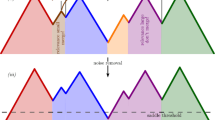Abstract
Cosmological N-body simulations on parallel computers produce large datasets--gigabytes at each instant of simulated cosmological time, and hundreds of gigabytes over the course of a simulation. These large datasets require further analysis before they can be compared to astronomical observations. The “Halo World” tools include two methods for performing halo finding: identifying all of the gravitationally stable clusters in a point-sampled density field. One of these methods is a parallel implementation of the friends of friends (FOF) algorithm, widely used in the field of N-body cosmology. The new IsoDen method based on isodensity surfaces has been developed to overcome some of the shortcomings of FOF. Parallel processing is the only viable way of obtaining the necessary performance and storage capacity to carry out these analysis tasks. Ultimately, we must also plan to use disk storage as the only economically viable alternative for storing and manipulating such large data sets. Both IsoDen and friends of friends have been implemented on a variety of computer systems, with parallelism up to 512 processors, and successfully used to extract halos from simulations with up to 16.8 million particles.
Similar content being viewed by others
References
Joshua E. Barnes and Piet Hut. A hierarchical O(NlogN) force-calculation algorithm. Nature, 324:446–449, 1986.
Donald J. Becker, Thomas Sterling, Daniel Savarese, John E. Dorband, Udaya A. Ranawake, and Charles V. Packer. Beowulf: a parallel workstation for scientific computation. In Tse yun Feng, editor, Proceedings of the 1995 International Conference on Parallel Processing, Volume 1: Architecture. CRC Press LLC, 1995.
E. Bertschinger and J. M. Gelb. Cosmological N-body simulations. Computers in Physics, 5:164–179, 1991.
R. G. Carlberg. Velocity bias in clusters. Astrophysical Journal, 433:468–478, 1994.
M. Davis, G. Efstathiou, C. S. Frenk, and S. D. M. White. The evolution of large-scale structure in a universe dominated by cold dark matter. Astrophysical Journal, 292:371–394, 1985.
J. M. Gelb and E. Bertschinger. Cold dark matter 1: The formation of dark halos. Astrophysical Journal, 436:467–490, 1994.
P. J. E. Peebles. Principles of Physical Cosmology. Princeton, 1993.
David W. Pfitzner. Density profiles of dark matter halos formed in dissipationless cosmology simulations. In M. Arnaboldi, G. S. Da Costa, and P. Saha, editors, The Second Stromlo Symposium: The Nature of Elliptical Galaxies, pages 109–110, San Francisco, 1996. Astronomical Society of the Pacific.
John K. Salmon and Michael S. Warren. Parallel out-of-core methods for N-body simulation. In Michael Heath, Virginia Torczon, et al., editors, Eigth SIAM Conference on Parallel Processing for Scientific Computing. SIAM, 1997.
David W. Scott. Multivariate density estimation: theory, practice and visualization. Wiley-Interscience, 1992.
B. W. Silverman. Density estimation for statistics and data analysis. Chapman and Hall, 1986.
F. J. Summers, M. Davis, and A. E. Evrard. Galaxy tracers and velocity bias. Astrophysical Journal, 454:1–14, 1995.
Michael S. Warren and John K. Salmon. A portable, parallel particle program. Computer Physics Communications, 87:266–290, 1995.
Michael S. Warren, John K. Salmon, Donald J. Becker, M. Patrick Goda, Thomas Sterling, and Grégoire S. Winckelmans. Pentiumpro inside: I. a treecode at 430 gflops on ASCI red, II. price/performance of $50/Mflop on Loki and Hyglac. In Supercomputing '97, Los Alamitos, 1997. IEEE Comp. Soc. in press.
W. H. Zurek, P. J. Quinn, J. K. Salmon, and M. S. Warren. Large scale structure after COBE: Peculiar velocities and correlations of cold dark matter halos. Astrophysical Journal, 431:559–568, 1994.
Author information
Authors and Affiliations
Rights and permissions
About this article
Cite this article
Pfitzner, D.W., Salmon, J.K. & Sterling, T. Halo World: Tools for Parallel Cluster Finding in Astrophysical N-body Simulations. Data Mining and Knowledge Discovery 1, 419–438 (1997). https://doi.org/10.1023/A:1009729602855
Issue Date:
DOI: https://doi.org/10.1023/A:1009729602855




